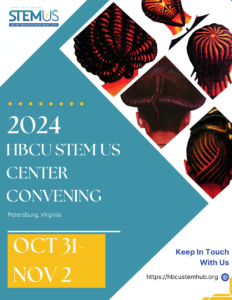Entry from the Just & Carver Blog published in 2017 under the STEM-Central websiteA doctoral student who was collecting data for his dissertation posed this question to me. Our interview had started off in the usual way but quickly diverged toward this unsettling inquiry once it was clear that he had already read my CV. He was interested in questions that were not on my CV: my experience as an NSF grantee; how I sustained my research program at an HBCU and why I was focusing on STEM education instead of my original interest in interleukin response to social stress in a rat model. All of this meandering led to the question- “What does it mean to be a Black Scientist?”
It’s not that I had never thought about that particular question. It is just that I’d rather not. The question is so laden with meaning and memory. It’s like pulling nylon thread out of decanedioyl dichloride in cyclohexane solution. The reaction occurs between the solution and molecules in the air, so as long as you stir and twirl the glass rod, the thread will continue to wrap around it like a liquid snake. A fitting analogy for what this graduate student was doing. He was stirring things up and agitating snakes that were better off, hidden and still…. But are they hidden or still?
Early in my career, I realized that writing a grant was the easy part. After receiving my very first NSF grant at an institution that was not an HBCU, I found myself being pulled into other directions. I was asked to join committees that were more about diversity than about science. Shouldn’t I care about the University’s stated intention to increase its number of minority students? More African American students wanted to work with me in the lab but many of them had no prior skills or experience. Shouldn’t I take the time to provide mentoring to them, even if it adds to the list of tasks and potentially slows down the research program? I was already juggling family obligations and community involvement. What can I drop so that I can spend more time in the lab?
I admitted to my young interviewer that eventually the research was compromised due to a lack of focus. The lack of focus was a result of the squeezing from other priorities. The choice of those priorities had a lot to do with being an African American woman. At that time, I actually believed the University’s stated intention. I understood my student’s need for my mentoring. I was committed to my family and my church and my sorority. So, when it came time to do reading from the databases and manuscript writing and planning the next project and budgeting the current project, there appeared to never be enough time for these important things. I’d chosen the mission over the research, before I even realized what I was doing.
This is not a new dilemma. Over one hundred years ago, two of the most famous African American scientists exemplified the benefits and costs of either choice. They were George Washing Carver and Earnest Everett Just.


After obtaining a Masters Degree from Iowa State University in 1896, George Washington Carver turned down an offer to work for Thomas Edison. Instead, Carver chose to pursue a science career at Tuskegee Institute where he outfitted his lab from items found in the local landfill. His pioneering work was credited for helping the entire American South salvage its cotton-depleted soil and produce a new cash crop- peanuts. He won international acclaim and national honors. Reflecting on his use of plants to create many common household products, Carver said that he never got a patent for his work because he felt that the starting materials rightly belonged to God. His 1943 epithet read: “He could have added fortune to fame, but caring for neither, he found happiness and honor in being helpful to the world.”
In 1907 Earnest Everett Just, graduated magna cum laude from Dartmouth College. His first job was at Howard University. After working as a researcher at the Woodshole Marine Biological Laboratory in Massachusetts, Just attended the University of Chicago where, in 1916, he earned a Ph.D. By 1920 Just had published 4 papers and obtained a 10 year fellowship at Woodshole, all while he continued to teach at Howard. However, unable to obtain funding and “hindered by racial discrimination” he left the U.S. for Europe in 1930 where he conducted pioneering research and published two books before the Nazi invasion forced his return to the U.S. and to Howard University, “one of the few institutions at the time that would hire a black scientist.” Earnest Everett Just died in 1941.
Fortunately, times have changed and there are many more opportunities open to scientist of color. However, the dilemma faced by Just and Carver remains with us: to choose the mission (and be ok with or without recognition) or focus on the research (and endure a type of personal sacrifice that the majority of our white colleagues will never understand.)
A recent article in the Chronicle of Higher Education reveals that African American scientists and women continue to be faced with this difficult choice between mission and research.
“People who struggle with questions of equity really struggle with career decisions,” said Mary Dillard, director of the graduate program in women’s history at Sarah Lawrence College. “Is it more important to do scholarship on equity or spend time with the student in your office who can’t call home for advice?” Ms. Dillard, who participated on the panel, said it can be a painful choice. “It’s kind of seen as though we’ve employed ourselves down,” said C. Cymone Fourshey, an associate professor of history and international relations at Bucknell University….”
This article offers insight through these personal vignettes that confirm what has also been shown in qualitative data. There is evidence of institutional bias in Higher Education ( Harper, 2012; Sandler and Hall, 1986; Stanley, 2006 ). that directly impacts the experiences of racial minorities and women (Hurtado, S., Eagan, M. K., Pryor, J. H., Whang, H., & Tran, S. ) This bias is rarely acknowledged (Kwan, 2013) but takes a toll on productivity (Eagan Jr, M. K., & Garvey, J. C. (2015). In addition, there is evidence of racial bias in the way that grants are reviewed and awarded (Ginther, D. K., Schaffer, W. T., Schnell, J., Masimore, B., Liu, F., Haak, L. L., & Kington, R. (2011). ), Besides the micro-aggressive and normative-approved racial/gender attitudes inflicted by the most liberal, well-educated and well-meaning colleagues, there is the additional threat of self-doubt. Just as the molecules in the air reacts with the solution to synthesize the nylon thread, the subtleness of this race-conscious environment threatens to confirm the stereotypes; the snake vivified by the air.
As my interview with the young doctoral student ended, he asked one final question, “What would I want NSF reviewers to know and understand about researchers from HBCU’s.” I didn’t say it to him but I would hope that they would at least take the time to read some of the research on racial disparity in higher education, starting with some of the articles I have cited here. However, much more than that, I would want them to become more aware and conscious; aware of the snakes that we carry and conscious of the air that they breathe.
References
Biography.com Editors George Washington Carver Biography
http://www.biography.com/people/george-washington-carver-9240299 accessed March 22, 2017
Wellner, Karen, “Ernest Everett Just (1883-1941)”. Embryo Project Encyclopedia (2010-06-16). ISSN: 1940-5030 http://embryo.asu.edu/handle/10776/2039 accessed March 22, 2017.
Biography.com Editors, Ernest Everett Just Biography, The Biography.com website http://www.biography.com/people/ernest-everett-just-9359195. Accessed March 22, 2017
Gluckman, Nell “Research or Mission? Professors of Color Face Tough Choices on Where to Work” – The Chronicle of Higher Education, March 16, 2017 http://www.chronicle.com/article/Research-or-Mission-/239502 accessed March 22, 2017)
Harper, S. R. (2012). Race without racism: How higher education researchers minimize racist institutional norms. The Review of Higher Education, 36(1), 9-29.
Sandler, B. R. and Hall, R. (1986). The campus climate revisited: Chilly for women fac- ulty, administrators, and graduate Students. Washington, DC: Project on the Status and Education of Women, Association of American Colleges
Stanley, C. A. (2006). Faculty of color: Teaching in predominately white colleges and universities. Bolton, MA: Anker Publishing Company, Inc.
Hurtado, S., Eagan, M. K., Pryor, J. H., Whang, H., & Tran, S. (2012). Undergraduate teaching faculty: The 2010–2011 HERI Faculty Survey. Los Angeles: Higher Education Research Institute.
Kwon, S. A. (2013). The comforts and discomforts of race. Learning and Teaching, 6(3), 39-50.
(Eagan Jr, M. K., & Garvey, J. C. (2015). Stressing out: Connecting race, gender, and stress with faculty productivity. The Journal of Higher Education, 86(6), 923-954.
Ginther, D. K., Schaffer, W. T., Schnell, J., Masimore, B., Liu, F., Haak, L. L., & Kington, R. (2011). Race, ethnicity, and NIH research awards. Science, 333(6045), 1015-1019.
Race without Racism: How Higher Education Researchers Minimize Racist Institutional Norms
Harper, Shaun R.
Review of Higher Education, v36 n1 suppl p9-29 Fall 2012
This article analyzes 255 articles published in seven peer-reviewed journals over a 10-year period and presents examples of how higher education researchers undertake the study of campus racial climates; racial differences in access, outcomes, and attainment; and the experiences of students, faculty, and administrators of color on predominantly White campuses without explicitly considering racism or attributing quantified racial inequities to racist institutional practices. The analysis found three consistent trends: (a) racial disparities are overwhelmingly attributed to factors other than racism, (b) scholars use semantic substitutes for “racism” and “racist,” and (c) critical race theory is rarely used for conceptual sense-making. (Contains 2 tables and 1 footnote.)
Descriptors: Higher Education, Postsecondary Education as a Field of Study, Racial Discrimination, Journal Articles, Content Analysis, Critical Theory, Race, Social Stratification, World Views, Theory Practice Relationship, Academic Discourse, Semantics, Racial Differences, Consciousness Raising, Perspective Taking, Self Concept, Social Attitudes, Researchers, College Environment
Johns Hopkins University Press. 2715 North Charles Street, Baltimore, MD 21218. Tel: 800-548-1784; Tel: 410-516-6987; Fax: 410-516-6968; e-mail: jlorder@jhupress.jhu.edu; Web site: http://www.press.jhu.edu/journals/subscribe.html
The Comforts and Discomforts of Race
Kwon, Soo Ah
Learning and Teaching: The International Journal of Higher Education in the Social Sciences, v6 n3 p39-50 Win 2013
Drawing on existing literature and student ethnographic projects, this article examines Asian American undergraduates’ overwhelming focus on individual racial identity and practices of racial segregation in their ethnographic research about the University of Illinois. The author examines how such racial segregation is described and analysed as a matter of personal “choice” and “comfort” rather than as the result of racial inequality, racism and the marginalisation and racialisation of minority groups. This lack of structural racial analysis in the examination of Asian American students’ experiences points to the depoliticisation and institutionalisation of race in higher education today. Race is understood and more readily analysed as a politically neutral concept that invokes celebration of racial diversity and “culture” and not as a concept marked by power and inequities as it once may have been.
Descriptors: Undergraduate Students, Racial Identification, Ethnicity, Racial Segregation, Ethnography, Asian American Students, Racial Attitudes, Student Research, Consciousness Raising
Berghahn Journals. 20 Jay Street Suite 512, Brooklyn, NY 11201. Tel: 212-233-6004; Fax: 212-233-6007; e-mail: journals@berghahnbooks.com; Web site: http://www.journals.berghahnbooks.com






Leave a Comment